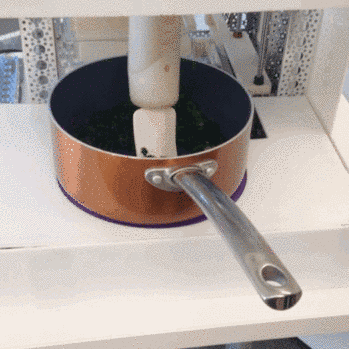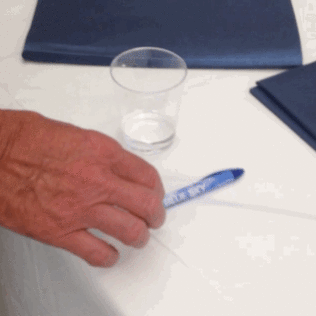On a sweltering afternoon in San Jose, California, in the cafeteria of a brand-new building called the Blue Sky Innovation Center, a robot is making a salad. Specifically, it's making a kale salad with goat cheese, blueberries, and sunflower seeds, partially heating the mixture to lightly melt the cheese.


The robot made the salad, but Timothy Chen, president and CEO of Sereneti, made the robot. Chen was demoing the his creation at the Korea Robotics Forum, hosted by Jabil, the global manufacturing company that just opened its Innovation Center, and by Silicon Valley Robotics, among others. Leading minds in emerging technology from the U.S. and Korea were present to talk robots and learn about the future of automation.
Most peoples' likeliest robot encounter — outside of a movie theater — is with a Roomba. Indeed, a representative from the company that made the Roomba, iRobot, was at the robotics forum, as was a Korean company, Robot of the Future, that makes a similar product, but for washing windows instead of vacuuming floors.
Beyond these unassuming domestic devices, the majority of robots in use in the US are big, industrial ones — machines as big as rooms, machines that can move cars, machines that could seriously injure and even kill a person standing where they shouldn't be.
For a while, this last concern was a big challenge for robotics. But technological developments have increasingly enabled manufacturers to build what are called collaborative robots — machines that can safely work alongside people. One of the most popular is friendly-looking Baxter, which can grip objects using vacuum suction or mechanical grippers and move them around without colliding with humans. Made by Rethink Robotics, Baxter will be joined by a cheaper sibling, Sawyer, later this year.
Here he is hard at work in the Innovation Center.
And here's what happens when a human being interferes:
Baxter isn't alone. BuzzFeed News previously reported on Fetch, a company that makes a pair of robots that can work together and with people to move objects in warehouses. There's also YuMi, a robot made by a Swiss corporation called ABB that can sit side by side with a worker and assemble electronics.
Watching this kind of robot in action — picking things up and putting them down or screwing objects into each other over and over — it's not hard to consider the number of tedious jobs that may soon be done without people. It seems possible that, in a not-too-distant future, the robots themselves will be running the place, a hypothetical scenario known in the automation biz as "lights out manufacturing."
Needless to say, there's a lot of interest — and a lot of money — in the prospect of being able to run a warehouse without having to hire, manage, insure — and, perhaps most crucially, pay — humans. Amazon made a splash in December of 2013 when it teased the idea of a drone-based delivery service, but the company's more near-term interest is much closer to earth. The company, and its competitors in the booming e-commerce industry, currently employ millions of people in warehouses around the world — people whose jobs could be eliminated simply by the invention of a robot that can efficiently select the correct item from a box, pick it up, and put it down where it's supposed to go. A robot like that could cut Amazon's cost by millions of dollars long before delivery drones do.
But the thing is, even that won't be easy — one reason Amazon recently held a contest in hopes of finding researchers who are making progress on this very problem.
The issue is that robots are really good at doing the same thing over and over again, but when a task calls for flexibility of any kind, it's almost always easier to have a human do it. For example, human hands can pick up any number of objects, but robots can't, explained Charlie Duncheon, co-founder of Grabit Inc. They don't have the ability to adjust.
Duncheon demonstrates that while a person can pick up a pen or a cup, a robot that can pick up a cup wouldn't know how to pick up a folder.



What seems simple for us is actually very tricky for robots — and for engineers. Whoever solves the grip problem will likely become very rich. "There are huge facilities just for e-commerce being built all over the world," Duncheon said. All of those facilities would save big time on labor costs if they had machines to do the miserably boring jobs that, according to Duncheon, they have a hard time hiring and retaining human employees to do.
The only thing to do, Duncheon says, is approach the problem on an application-by-application basis. For example, he estimates that there are tens if not thousands of people who spend all day feeding small pieces of fabric into sewing machines. Why? Because vacuum grippers on robots will suck them up, and mechanical grippers will cause them to bunch. In that, Duncheon — who has been in the robot business for over 25 years and calls himself a "dirt under the fingernails" automation guy — saw an opportunity. Which is how he came to be at the Korean Robotics Forum touting the innovative excellence of an electrostatic fabric gripper. Here it is gripping his cell phone.
Given that Duncheon said Grabit's big challenge and singular focus is on the electrostatic gripper — a technology that does nothing more than allow a machine to pick up a square of fabric the size of a jeans pocket — it suddenly seems like factory floors full of Baxter's grinning, backlit LED "face" is a more distant future than we sometimes imagine it to be.
And, there's this: In a globalized economy and unequal world, the price of human labor is still lower than the cost of sinking millions of dollars into this type of robot R&D. "People in China are generally more efficient and cheaper than robots," said John Dulchinos, Jabil's vice president for digital manufacturing. Dulchinos envisions a future where both skilled and unskilled workers labor alongside robots in smarter, more efficient, but no less human workplaces than the manufacturing plants of today. People are necessary and — for now, at least — also cost efficient.
By the end of the day, the Blue Sky cafeteria had morphed into something of a bar, with the garage door up and the hot, late afternoon sunlight streaming in. Sitting at a high top table was Gavenraj Sodhi, who had flown in to Silicon Valley that day from China to attend the event. Sodhi was sharing his table with a Heineken and prototype of his two-foot-tall educational robot for children, both of which were, at this point, inert.
I asked Sodhi what the biggest difference was between the robotics scene in China and the products on display at the Innovation Center. His answer was immediate and decisive: The American focus on manufacturing. While the Chinese market is flooded with whiz-band personal gadgets, the real money is in moving boxes and making pants. And so it's there that the real game-changing innovations — like solving grippers — will happen.
Plus, he said, Hollywood is constantly coming out with another movie where robots turn out to be evil or go haywire and kill everyone, which doesn't make them seem like enticing new gadgets to bring into the home. On top of that, he said, no family can afford an $8,000 robot.
So it's in factories and plants that the market will smooth out the inefficiencies, and push the technology forward, and there that regular people — not the people eating crab cakes and drinking wine in an Innovation Center in San Jose – will encounter real-life robots for the first time. At least, that's what Sodhi's counting on as he works on developing on a smaller, hipper prototype of his educational, family-oriented for teens that would go to market in the low hundreds.
Meanwhile, making a salad seems like a greater feat than originally imagined.
